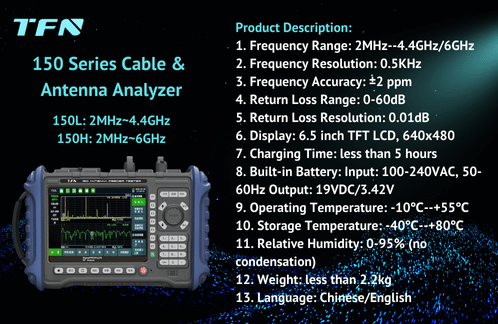How to detect cable loss with cable antenna analyzer?
Cable antenna analyzer, also known as standing wave ratio tester, is an electronic device specially used to test the standing wave ratio, matching and cable loss of base station antennas and feeders. It can quickly evaluate the condition of transmission lines and antenna systems, and speed up the installation and commissioning time required for new base stations. This article will introduce in detail how to detect cable loss with cable & antenna analyzer, which can be used as a reference for users.
1. Detection principle
The principle of detecting cable loss with antenna analyzer is mainly based on return loss measurement. Connect an open circuit or short circuiter at the far end of the cable, and calculate the loss value of the cable by measuring the loss of the reflected signal in the signal transmission path.
2. Main steps
2.1. Preparation phase
Check the equipment: ensure that the antenna feeder analyzer functions normally, the battery is fully charged, and the accessories such as calibrator and test line are complete.
Set test parameters: Set the corresponding test parameters on the antenna feeder analyser according to the specifications of the cable to be tested (such as frequency range, impedance, etc.) and test requirements.
2.2. Calibration phase
Perform calibration: Use the calibrator to calibrate the cable antenna analyzer for open circuit, short circuit and load to ensure the accuracy of the test results. The calibration steps should be strictly followed in accordance with the user manual of the tester.
2.3. Connect the cable
Connect the tester and the cable: Connect the test port of the tester to one end of the cable to be tested through the test line, and the other end can be connected to a standard load, open circuit or short circuit, depending on the test method.
2.4. Test phase
Start the test: Select the appropriate test mode (such as standing wave ratio test, return loss test, etc.) on the cable antenna analyzer, and then start the test program.
Observe the results: After the test is completed, observe the display results on the tester, including parameters such as standing wave ratio and return loss, which will be used to calculate the loss of the cable.
2.5. Calculation and Analysis
Calculate loss: Based on the return loss data provided by the tester, combined with the length and characteristic impedance of the cable, the insertion loss of the cable can be calculated.
Analyze results: Compare the calculated loss value with the standard value or historical data to analyze whether the cable loss is within the acceptable range.
2.6. Record and Report
Record data: Record the test results in the test report, including the test date, tester, cable specifications, test parameters, loss value, etc.
Generate report: Generate a detailed test report based on the test data for subsequent analysis and reference.
3. Precautions
Calibration accuracy: The cable antenna analyzer needs to be recalibrated before each test to ensure the accuracy of the measurement results. In particular, recalibration is required when changing the test frequency, temperature, or replacing the test cable.
Connection stability: During the test, the connection between the cable and the tester must be kept stable. Avoid moving or bending the cable during the test to avoid affecting the measurement results.
Environmental interference: During the test, be careful to prevent external co-frequency signals from entering the system and causing measurement errors. You can choose to test in a well-shielded environment to reduce the impact of external interference.
Test parameter selection: Select appropriate test parameters based on the type of cable and test requirements. Ensure that the selected parameters can accurately reflect the loss of the cable.
Test data recording and analysis: After the test is completed, record the test results in a timely manner and compare them with historical data. By analyzing the changing trend of the test results, potential problems with the cable can be discovered in a timely manner.
Tester maintenance: Regularly maintain and service the cable antenna analyzer to ensure that it is in good working condition. Replace damaged parts or calibration parts in a timely manner to ensure the accuracy of the test.
By following the above steps and precautions, you can ensure that the antenna and cable tester can accurately detect cable loss and provide support for the maintenance and management of wireless communication systems.
The TFN 150H cable antenna analyzer is powerful and has remarkable features. It has high test accuracy and a wide test range (measurable frequency covers 2MHz-6GHz), and can measure standing wave ratio, return loss, etc. The tester's intelligent operation interface and powerful data processing capabilities make testing more convenient. It can adapt to a variety of antenna and feeder systems to meet diverse needs, provide strong support for communications and other fields, and help users improve work efficiency and test accuracy.

If you are interested in the TFN 150H cable antenna analyzer, please contact the TFN sales team:
Email: info@tfngj.com
WhatsApp: +86-18765219251
Facebook: https://www.facebook.com/tfnfate/
